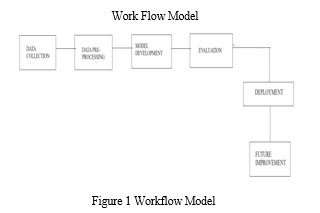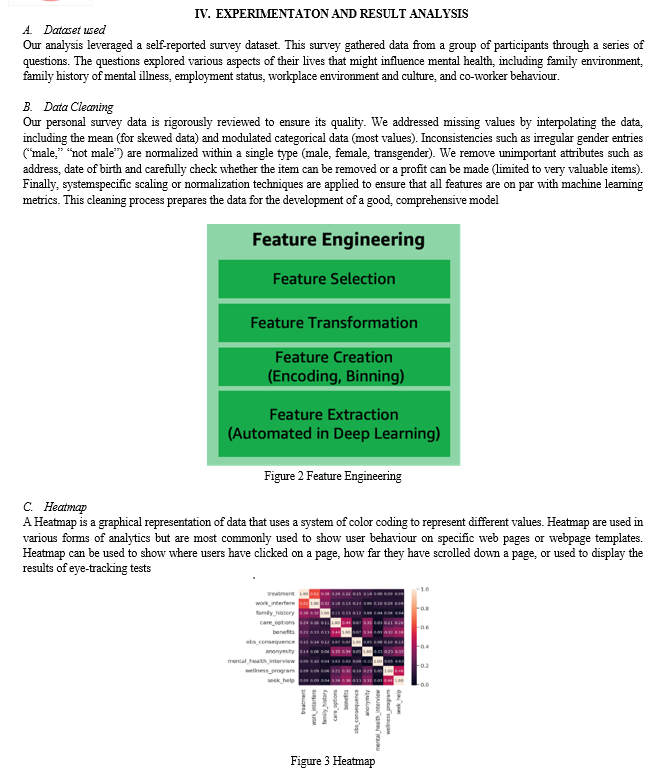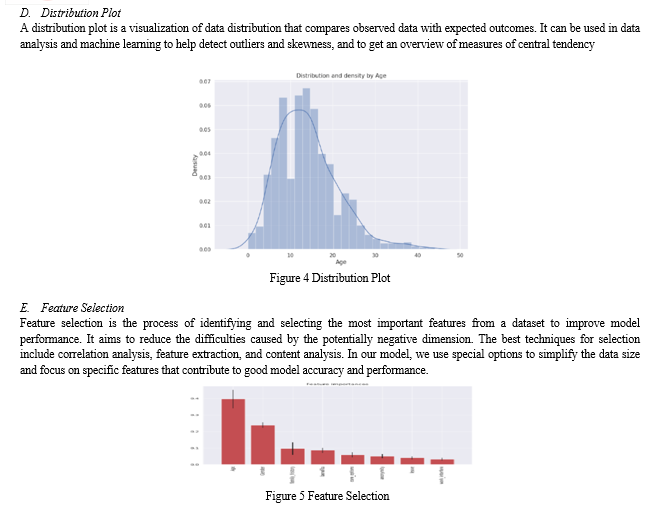Ijraset Journal For Research in Applied Science and Engineering Technology
- Home / Ijraset
- On This Page
- Abstract
- Introduction
- Conclusion
- References
- Copyright
AI Mental Health Tracker and Analyzer Using Machine Learning Technique
Authors: Prof. Sony Kumari, Vraddhi Jain, Ritik Sangwan, Shivani Saxena
DOI Link: https://doi.org/10.22214/ijraset.2024.62498
Certificate: View Certificate
Abstract
Mental health problems are one of the major concerns of the 21st century in the field of healthcare. One of the major reasons behind this problem is lack of awareness among masses. The increase of mental health problems and the need for effective medical health care have led to an investigation of machine learning that can be applied in mental health problems. Early detection of mental health issues allows specialists to treat them more effectively and it improves patient’s quality of life. Mental health is very important at every stage of life, from childhood and adolescence through adulthood. This study amalgamates insights from diverse research endeavours to present a comprehensive systematic review of machine learning (ML) applications in the mental health domain. In this research paper techniques like Logistic Regression, K-NN, Decision Trees, Random Forest, and Support Vector were compared, with Random Forest proving most accurate at 73.16% prediction accuracy.
Introduction
I. INTRODUCTION
Mental health is a state of internal well- being that enables people to manage with the stresses of life, realize their capacities, learn well and work well, and contribute to their community. Prolonged isolation and uncertainty during the pandemic has increased stress and anxiety for many people. Financial problems, unemployment and social restrictions worsen mental health problems. Unfortunately, fear of judgment prevents people from seeking help, causing some to turn to drug addiction as a solution. Breaking the stigma surrounding mental health is important to encourage open discussion and provide support to those who need it. According to WHO internal health is “further than the absence of internal diseases.” Peak internal health is about managing active conditions and maintaining heartiness and happiness. According to government statistical data out of the whole population of India, 130 million people could be suffering from some kind of internal illness.
A large quantum of India’s population is living below the poverty line; these people don’t have access to proper sanctum, food, water, drug, etc. For them proper treatment of internal illness is still a distant dream. Indeed for the top 10 percent of the population, treatment is expensive. According to world health association data India has 0.75 psychologists and psychiatrist per 100,000 people, when compared to Argentina which is a world top leader in this has 106 psychologists per 100,000 people. To overcome this implicit epidemic of internal illness, the government has to take some strong and necessary way towards healthcare, furnishing a sufficient budget towards internal health. The main reason behind such a huge number of people suffering from internal illness is our atrophied healthcare system. Anxiety and depression are serious public health issues that affect people each over the world. They affect people of all periods, from children to the senior, including both men and women.
Machine literacy is a fashion that aims to construct systems that can ameliorate through experience by using advanced statistical and probabilistic ways. It's believed to be a significantly useful tool to help in prognosticating internal health. In this paper, the main ideal is to give a methodical literature review, critical review, and summary of the machine literacy ways that are being used to prognosticate, diagnose, and identify internal health problems. Some of the major internal health diseases, similar as habitual conditions, bipolar complaint, and schizophrenia they don’t suddenly arise out of nowhere; they frequently develop over time and produce symptoms that can be honoured in the early stages similar diseases could be avoided or controlled more successfully. If abnormal internal countries are discovered beforehand in the complaint’s course when redundant treatment and care can be handed. Technological advancements similar as smart phones, social media, neuroimaging, and wearable have enabled experimenters of internal health and croakers to gather a tremendous quantum of information at a rapid-fire rate. Machine literacy has developed as a dependable tool for assaying these of all Classifiers more fluently and rightly discovered, as well as more accurate prognostications from data sources. Natural language processing, speech recognition, computer vision, and Artificial intelligence have all served from machine literacy, which allows inventors and experimenters to prize pivotal data from datasets, deliver substantiated gests, and develop intelligent systems. In disciplines like bioinformatics, ML has backed substantial progress by allowing for quick and scalable analysis of complicated data.
II. LITERATURE REVIEW
In 2015, Filip Dabek and Jesus J Caban introduced a groundbreaking neural network model designed to predict psychological conditions post-concussion with remarkable accuracy. By leveraging this model, they aimed to enhance preventive care for individuals with mild traumatic brain injury (mTBI). Their study not only demonstrated high predictive accuracy ranging from 73% to 95% but also outperformed previous methodologies. This innovation presented a significant step forward in clinical applications, potentially revolutionizing how psychological conditions are addressed and managed in patients recovering from mTBI.
A subsequent pilot study conducted in 2023 by Mahr F, Waschbusch D A, and Vgontzas delved into the efficacy of prazosin as a treatment for PTSD-related nightmares in women with bulimia nervosa. This study addressed a crucial gap in understanding the interplay between bulimia nervosa, PTSD, and the efficacy of prazosin in alleviating associated symptoms. While acknowledging its limitations, the study provided promising results, indicating a positive impact on nightmare intensity and frequency. However, it underscored the necessity for further research with larger sample sizes and the exploration of combined treatment approaches such as cognitive-behavioral therapy (CBT) alongside prazosin.
In 2019, Gyeongcheol Cho, Jinyeong Yim, Younyoung Choi, Jungmin Ko, and Seoung-Hwan Lee conducted a comprehensive review of machine learning (ML) algorithms for diagnosing mental illness. Their analysis focused on commonly employed ML techniques such as Support Vector Machines (SVM), Gradient Boosting Machines (GBM), Random Forest, k-Nearest Neighbors (KNN), and Naïve Bayes. Through a systematic organization of findings, they shed light on the applications and effectiveness of these algorithms in various mental health domains, including PTSD, schizophrenia, depression, Autism Spectrum Disorder (ASD), and bipolar disorder. This review provided valuable insights into the utilization of ML in mental health research, emphasizing the potential of supervised learning for classification tasks in diagnosing and managing mental illnesses.
Machine learning, as underscored by M. I. Jordan and T. M. Mitchell in 2015, has undergone a profound transformation from a scientific curiosity to a commercially prevalent technology. Its evolution has led to widespread adoption across diverse sectors, including computer science, user services, and supply chain management. This shift highlights the efficiency and practical utility of machine learning in addressing complex challenges and optimizing processes in various industries. As machine learning continues to advance, its impact on society and its applications in critical areas such as healthcare are expected to grow exponentially, promising further innovations and improvements in patient care and management of psychological conditions.
III. METHODOLOGY
The methodology for developing the AI-powered mental health tracker and analyzer focuses on leveraging machine learning techniques and behavioral therapy principles to create a comprehensive tool for mood tracking and mental health management.
A. Proposed System
The main compass of our design is to describe mental health vaticination and to design a bracket model with a help of a machine learning algorithm.
B. Data Pre-manipulation
This particular scrap of the report will graft the data, and examine the standard of data cand also trim and clean the given dataset for analysis.
C. Data Graphing
The data set collected for prognosticating given data is resolve into the training set and a testing set. Generally, 73 rates are applied to split the Training set and Test set. The Data Model which was created using machine literacy algorithms is applied to the Training set and grounded on the test affect delicacy. Then matplotlib is used for data visualization.
D. Designing the Classification model
Classification is a supervised machine learning fashion that group records into sets of homologous compliances associated with particular classes. Different classifiers or bracket algorithms are available. In this study, six different classifiers were trained, including k-nearest neighbor, naive Bayes, random forest, decision tree, logistic regression.
- Logistic Regression algorithm
It's a classification algorithm in the fashion of machine learning which is used to describe the possibilities of a categorical dependent variable. The purpose of logistic retrogression is to find the exact model to unfold the association between the bifurcate specific of interest (measured variable = reply or final output variable) and a set of variables.
2. Decision Tree Classifier algorithm
Decision- tree algorithm is one of the most effective order and well familiar order of supervised learning algorithms. It's suitable for nonstop and categorical variables of the affair. Decision tree constructs classification or regression models and assembles it in a confirmation of a tree. It breaks down the sets of data into inferior and inferior subsets while coincidently anco-related decision tree is incrementally designed. A root knot has two or further branches and a splint knot which represents a classification or a categorical decision. It's designed in a top-down recursive approach and in a peak and- conquer manner. i.e., 80 percent of it goes for training the model and the rest 20 percent is used to test the delicacy of the model. Through exploration we've named the following machine learning algorithms to find the stylish possible algorithm that could give us the most delicacy.
3. Random Forest Algorithm
It's an algorithm that comes under supervised form of learning. The working principle is to produce multiple decision trees and all of them are combined to get precise prognostications. Hence, it's considered a popular machine learning algorithm.
4. Decision Tree Algorithm
A decision tree comes under supervised learning algorithms where data is continuously resolve according to the parameter. The tree consists of two effects i.e., decision bumps and leaves. Decision knot is the stage where data is resolve and all the choices made are the leaves.
5. K- Nearest Neighbor Algorithm
Also known as a lazy or non parametric algorithm. The algorithm is actually grounded on point similarity. The vaticination is done according to the computation of the nearest data points. As it stores all of the training data, it can be computationally precious when working on a large dataset.
6. Naive Bayes Algorithm
It's a classifier which is grounded upon tentative probability models. These classifiers are a set of classification algorithms that are grounded on Bayes Theorem. It’s a group of algorithms where a common principle is participated between them be categorical. The Naive Bayes algorithm is an intuitive system that uses the chances of each trait belonging to each class to make a vaticination. Naive bayes simplifies the computation of chances by assuming that the probability of each trait belonging to a given class value is independent of all other attributes



Conclusion
Mental health significantly impacts our daily functioning and overall well-being, influencing both personal and professional lives. Depression, recognized by the World Health Organization as a leading global mental health issue, underscores the importance of prioritizing mental wellness. Many individuals understand the need for mental health care but hesitate to seek professional help. Innovations like the Mental Health Tracker app bridge this gap by providing an accessible platform for users to explore their mental state. Through targeted questions, the app helps users articulate their thoughts and feelings, generating personalized tasks and activities accordingly. It also offers visual progress tracking through weekly graphs, enhancing user understanding of their mental health patterns. Leveraging technology, such apps can identify symptoms of depression and deliver customized guidance, potentially improving users\' mood and overall health. Collaboration with mental health professionals ensures these tools are effective and meet user needs. Empowering individuals to manage their mental health is essential for fostering a healthier, more productive society. Current research in brain diagnosis using machine learning focuses predominantly on one type of data. However, future advancements could see improved accuracy from integrating multiple data sources such as speech patterns, facial expressions, EEG data, and social behavior analysis. Developing new models capable of synthesizing these diverse inputs, alongside specialized information systems for audiovisual analysis in mental health, will be crucial. Such advancements could lead to earlier interventions, enhanced treatments, and ultimately better mental health outcomes.
References
[1] Mobile Mental Health: A Review of Applications for Depression Assistance (2019) by Ariel Teles [2] Mental Health Monitoring System Using Artifical Intelligence: A Review (2019) by Vidhi Mody [3] Smartphone-Based Tracking of Sleep in Depression, Anxiety and Psychotic Disorders (2019) by Talayeh Aledavood [4] PsyHeal: An Approach to Remote Mental Health Monitoring System (2018) by Vivek Patel [5] Towards Situation-aware Mobile Application in Mental Health (2019) by Ariel S. Teles [6] Monitoring Mental Health Using Smart Devices With Text Analytical Tool (2019) by N.S. Algamdi [7] EmoKey: An Emotion-aware Smartphone Keyboard for Mental Health Monitoring (2019) by Surjya Ghosh [8] Mental Health Care Towards Effective Self Care Through Digital Technology [9] User\'s Perception on Mental Health Applications: A Qualitative Analysis of Users Reviews (2018) by K.S. Thach [10] Predicting Anxiety, Depression and Stress in Modern Life Using Machine Learning Algorithms (2019) by Anu Priya [11] John McCarthy. Artificial intelligence, logic and formalizing common sense In Philosophical logic and artificial intelligence 1989. [12] Turing AM. Computing Machinery and Intelligence. Comput Mach Intell. [13] Jiang F, Jiang Y, Zhi H, Dong Y, Li H, Ma S, et al. Artificial intelligence in healthcare: [14] Hengstler M, Enkel E, Duelli S. Applied artificial intelligence and trust — the case of autonomous vehicles and medical assistance devices. [15] Beam AL, Kohane IS. Translating Artificial Intelligence Into Clinical Care. [16] Bishnoi L, Narayan Singh S. Artificial Intelligence Techniques Used in Medical Sciences: A Review. Proc 8th Int Conf Conflu 2018 Cloud Comput Data Sci Eng Conflu 2018 [17] Fogel AL, Kvedar JC. Artificial intelligence powers digital medicine. [18] Kar SK, Kabir R, Menon V, Arafat SMY, Prakash AJ, and Saxena SK (2021) Artificial intelligence in mental healthcare during COVID-19 pandemic. In: Applications of Artificial Intelligence in COVID-19. Nandan Mohanty S, Saxena SK, Satpathy S, and Chatterjee JM, (Eds). Springer, Singapore pp 327–343 [19] Kavitha V, Akila C (2022) A deep learning approach toward prediction of mental health of Indians. Artificial intelligence, machine learning, and mental health in pandemics. Elsevier, Amsterdam, pp 141–165 [20] Kharbat FF, Alshawabkeh A, Woolsey ML (2021) Identifying gaps in using artificial intelligence to support students with intellectual disabilities from education and health perspectives. Aslib J Inf Manag 73(1):101–128 [21] G. Cho, J. Yim, Y. Choi, J. Ko, and S.-H. Lee, “Review of machine learning algorithms for diagnosing mental illness,” Psychiatry Investigation, vol. 16, no. 4, pp. 262–269, 2019
Copyright
Copyright © 2024 Prof. Sony Kumari, Vraddhi Jain, Ritik Sangwan, Shivani Saxena. This is an open access article distributed under the Creative Commons Attribution License, which permits unrestricted use, distribution, and reproduction in any medium, provided the original work is properly cited.

Download Paper
Paper Id : IJRASET62498
Publish Date : 2024-05-22
ISSN : 2321-9653
Publisher Name : IJRASET
DOI Link : Click Here
 Submit Paper Online
Submit Paper Online

